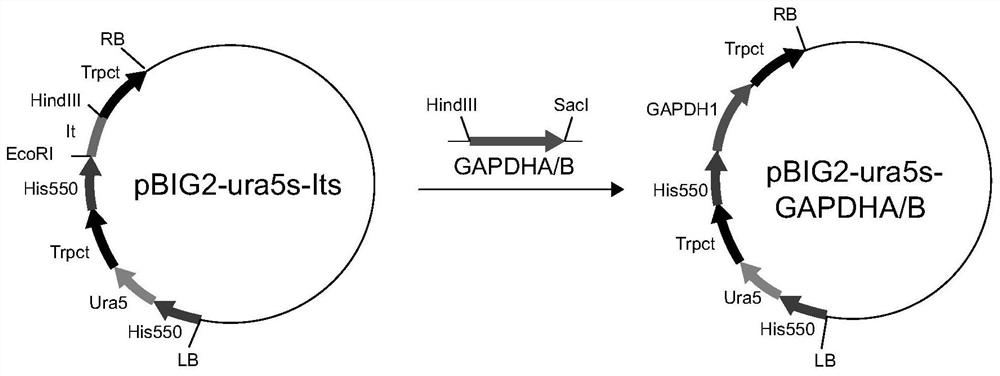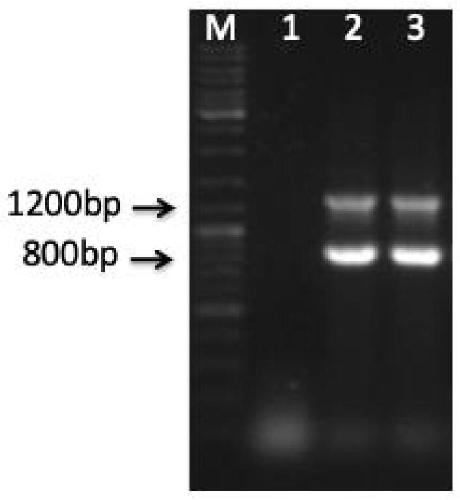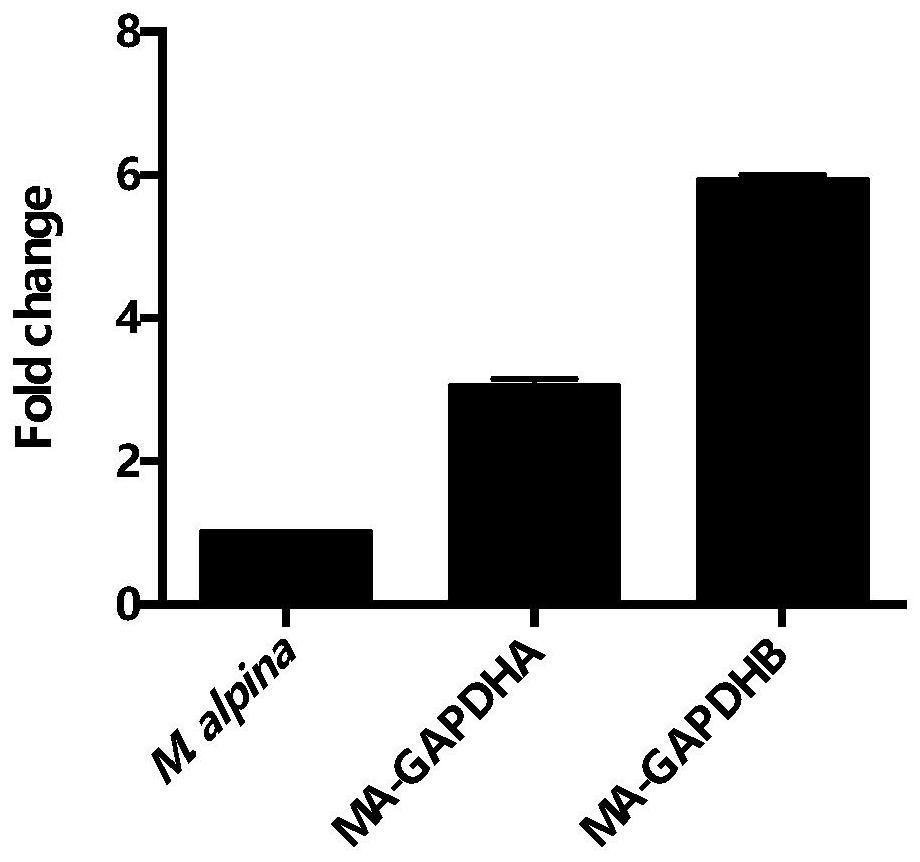A kind of 3-phosphate glyceraldehyde dehydrogenase and its application
A technology of glyceraldehyde phosphate dehydrogenase and triglyceride, applied in the field of glyceraldehyde 3-phosphate dehydrogenase, can solve the problems of high cost of animal and plant cultivation, long growth cycle and the like, and achieve the effect of improving the ability of microorganisms to resist acid stress
- Summary
- Abstract
- Description
- Claims
- Application Information
AI Technical Summary
Problems solved by technology
Method used
Image
Examples
Embodiment 1
[0067] Example 1: Screening of genes encoding MaGAPDHA and MaGAPDHB
[0068] Specific steps are as follows:
[0069] In NCBI, the gapdh gene sequences with identified functions in different species were selected as templates (Table 1), and BLAST comparison was performed in the gene bank of the sequenced M.alpinaATCC 32222 strain to obtain alternative target genes; The selected genes were compared and screened for the second time in the NCBI library, and the finally obtained target genes were named Magapdha (nucleotide sequence as shown in SEQ ID No.3) and Magapdhb (nucleotide sequence as shown in SEQ ID No.4) ), and the corresponding proteins are named MaGAPDHA (amino acid sequence shown in SEQ ID No.1) and MaGAPDHB (amino acid sequence shown in SEQ ID No.2).
[0070] In order to further determine whether the screened MaGAPDHA and MaGAPDHB belong to GAPDH enzymes, they were compared with the amino acid sequences of five typical GAPDHs in Table 1, which were derived from anima...
Embodiment 2
[0075] Example 2: Cloning of Magapdha and Magapdhb
[0076] Specific steps are as follows:
[0077] The total RNA of Mortierella alpina (Mortierella alpina) ATCC 32222 was extracted using the Trizol method, and cDNA was obtained by reverse transcription according to the instructions of the Takara reverse transcription kit. The reaction amplifies Magapdha and Magapdhb, and the primers used for amplifying Magapdha and Magapdhb are shown in Table 2.
[0078] The PCR instrument used is BIO-RAD T100 Thermal Cycler, using KOD plus high-fidelity DNA polymerase, the reaction system is 50 μL, and the content of the system is carried out according to the instructions of the DNA polymerase; the reaction process is as follows: 95°C for 3min, 95°C for 30s, 55°C for 30s , 68°C 1min 5s, 30 cycles, 68°C 5min.
[0079] After the reaction is completed, the amplified product is obtained, and after the amplified product is purified, the band size of the amplified product is verified by 1% agaro...
Embodiment 3
[0082] Example 3: Expression of Magapdha and Magapdhb in Mortierella alpina
[0083] Specific steps are as follows:
[0084] (1) Construction of Mortierella alpina expression vector
[0085] Such as figure 1 , the Magapdha obtained in Example 2 and the expression vector pBIG2-ura5s-ITs were digested with the restriction endonuclease Hind III, and the digested product was digested with the restriction endonuclease Sac I. 4The ligase connects the digested products that have been digested by HindIII and SacI successively to obtain the ligated product;
[0086] The Magapdhb obtained in Example 2 and the expression vector pBIG2-ura5s-ITs were digested using restriction endonuclease Hind III, and the digested product was digested using restriction endonuclease Sac I. 4 The ligase connects the digested products that have been digested by HindIII and SacI successively to obtain the ligated product;
[0087] Among them, HindIII digestion system (20 μL): 2 μL HindIII-FD, 2 μg plasmi...
PUM
 Login to View More
Login to View More Abstract
Description
Claims
Application Information
 Login to View More
Login to View More - R&D
- Intellectual Property
- Life Sciences
- Materials
- Tech Scout
- Unparalleled Data Quality
- Higher Quality Content
- 60% Fewer Hallucinations
Browse by: Latest US Patents, China's latest patents, Technical Efficacy Thesaurus, Application Domain, Technology Topic, Popular Technical Reports.
© 2025 PatSnap. All rights reserved.Legal|Privacy policy|Modern Slavery Act Transparency Statement|Sitemap|About US| Contact US: help@patsnap.com



